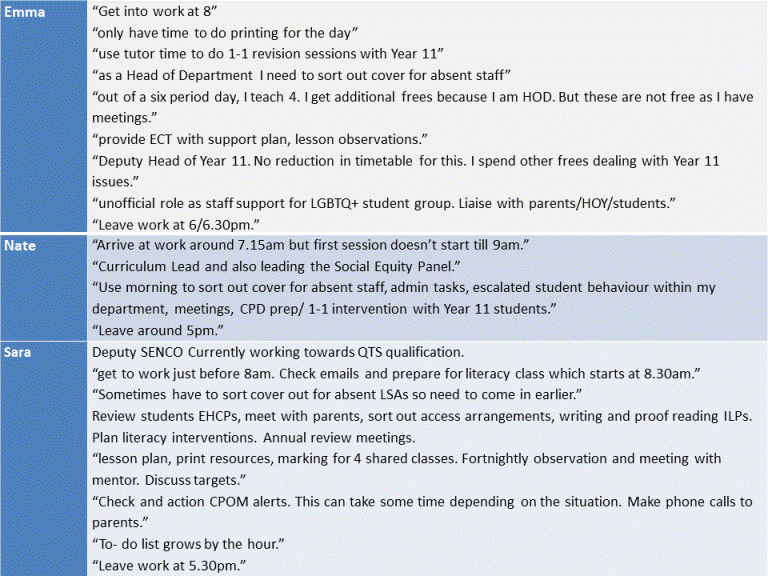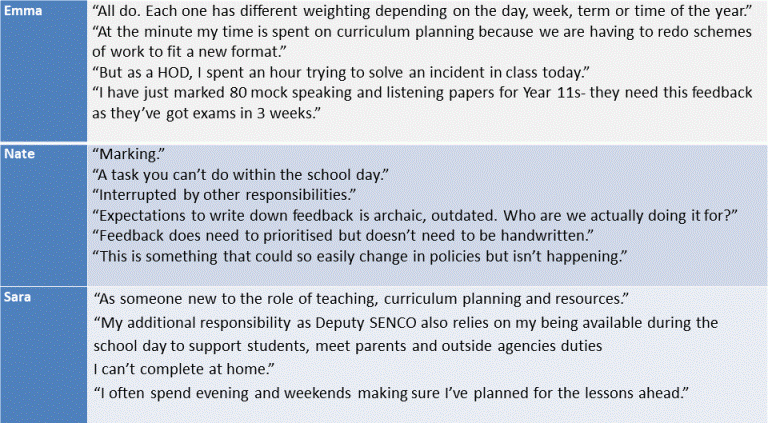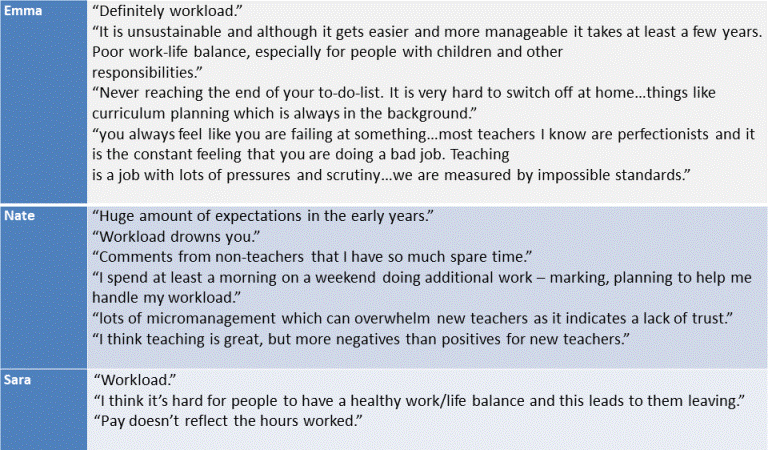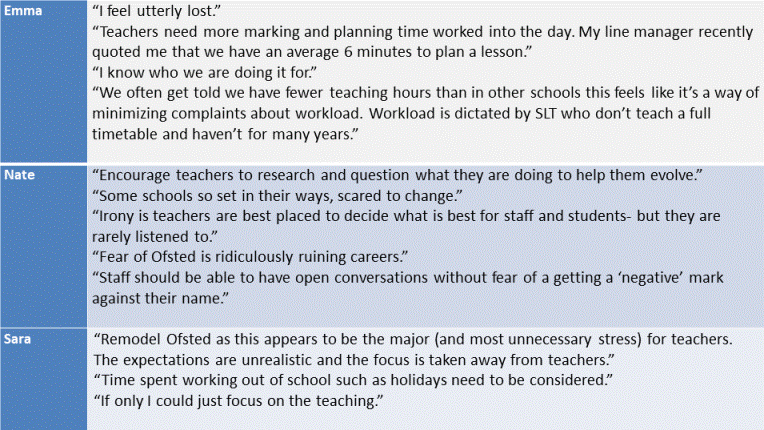Summary
Teachers’ workload and its impact on staff recruitment and retention are a growing concern. This essay examines the perspectives of three teachers working in a secondary school in the UK and shows how workload has impacted their careers. Through the use of email interviews, the paper aims to explore the perspectives of the individuals, providing a glimpse into the wider issues surrounding teachers’ workload. The paper concludes that despite past efforts, teachers’ workload concerns still persist. If we are to save the teaching profession, then action from our constitutional government is urgently needed.
Context
As a teacher of 12 years, workload has been a consistent area of concern to me. Having experienced firsthand (pre and post COVID-19) the growing demands on the profession and witnessing fellow educators leave the profession altogether, teachers’ workload seems to be a timely topic to be addressed. My hope for this essay is to highlight the fact that despite numerous government initiatives, workload continues to be a major issue that drives teachers out of the profession, and to determine whether the interview data support my view and experience on teacher workload.
Teacher workload concerns: What are the causes and effects?
Background and Rationale
This essay examines teacher workload in one UK secondary school. The essay uses email interviews with three teachers in an attempt to detail their perspectives on the issues surrounding workload. The essay analyses government initiatives across twenty years and highlights the growing concerns researchers, educational practitioners and leading figures in government have expressed over teacher retention and recruitment. The purpose of the email interviews was to help unveil how teachers in 2022, post COVID-19, describe their workload and their views on the factors impacting teachers. The interviews were carried out in my current place of employment, with three participants who were and are fellow colleagues. Email interviews were conducted from April 2022-May 2022.
For the purpose of this study, I adopted a subjective approach, what Taber (2007) describes as an approach of a “biographical nature” (2007: 9). Work by Schaenen, Kohnen, Flinn, Saul, and Zeni (2012) advocates the use of the first person in research. As the authors argued, rather than avoiding the use of “I”, “research must acknowledge who is interpreting” (2012: 87). In the present case, I draw upon my own teaching experiences as a starting point.
I have been a secondary school English teacher for the last twelve years. From my initial NQT (Newly Qualified Teacher) years to now being a middle leader within the English Department, my career has seen its own achievements and challenges. Perhaps one of the most prominent challenges faced by educational professionals who have taught in the last two years has been teaching through COVID-19. This became a global challenge, which changed many aspects of teaching overall.
Historical Background on Efforts Made by Government and the Department for Education
Former Prime Minister David Cameron alongside his Deputy Nick Clegg shared fearful insights into the state of education in 2010. The foreword to their White Paper report warned, “tweaking things are not an option” and that reform of education was “absolutely essential” (Department for Education [DfE], 2010: 10). The former Secretary of Education, Michael Gove, provided his view of the importance of teachers in the bigger reform picture. In his introduction, he describes the teacher as society’s “most valuable asset” and that no other career is “more noble, vital and important” than the teaching profession (DfE, 2010: 10).
In 2016, Nicky Morgan, then Secretary for Education, led the Educational Excellence Everywhere (DfE, 2016) report echoing similar warnings to Gove regarding the importance of reform; an acknowledgement of the “bold” reforms her predecessor introduced and the need to “build and extend” these reforms (p. 6). However, Morgan’s educational report strayed slightly away from the 2010 White Paper obscurities. In the 2016 report, there was recognition of teachers’ workload as an issue. This paper called for yet another attempt to reduce the “unnecessary bureaucracy and requirements” (p.15), and thus made a bid to reduce teacher workload yet without defining examples.
In the same year, 2016, the DfE published its own Teacher Workload Survey (TWS) stating “classroom teachers and middle leaders in secondary schools spent an average 33 hours on non-teaching tasks” (DfE, 2016: 6). The survey also revealed secondary school teachers “were three times likely to undertake cover for absent staff” (p. 6). The researchers compared their findings to the TALIS (The Teaching and Learning International Survey) 2013 report. The TWSrevealed “secondary school teachers reported spending more time” on several factors including marking in comparison to the data that had been gathered by TALIS three years prior. The findings of the TWS study suggested that teacher workload had indeed increased, making it difficult to see a positive impact of the government policies previously discussed. See also TWS survey results published in 2019 (Walker, Worth, and Van den Brande, 2019).
In 2018 TALIS conducted their latest international report on teachers and school leaders. Worryingly, England (UK) was one of seven countries to have experienced a “significant deterioration in the perceived prestige of the [teaching] profession” (Schleicher, 2018: 3) since the previous TALIS report in 2013. The study revealed full time secondary teachers in England worked 49 hours on average per week, with 57% of secondary school teachers describing their workload as unmanageable (p. 25). In light of these findings, it is hard to escape the conclusion that Gove’s earlier definition of the teacher as the most “valuable asset” had long disappeared.
Surveys like TALIS are useful in capturing a large-scale overview; however, it is important to note that these overviews are predominately based on the individual’s perceptions of what constitutes a “high workload” in their role. This can vary not only between groups of teachers, but amongst individuals working within the same school.
The DfE’s School workload reduction toolkit was published in 2018. This tool was useful as it gave recognition to the problem haunting the teaching profession for many years. Its aims, as the policy behind the tool states were to “identify workload issues…address workload issues…evaluate the impact” (DfE, 2018). Tidd (2018), an author for The Times Educational Supplement, is very much dismissive of the DfE’s attempt here. His use of sarcasm about the “poor folk at the Department of Education” (Tidd, 2018: 27) challenges the credibility of this policy. Tidd argues that the main workload issue stems from the leaders (Department of Education) themselves, therefore getting schools and their leaders to identify workload issues in their own school is meaningless. He notes that the 2018 toolkit is extensive in providing a list of suggested activities for schools to use to scrutinise their workload levels. Tidd’s stance and comments are seminal in that the toolkit does add questions but fails to provide answers.
However, the toolkit does have its strengths. Its suggestions are aimed at schools and their leaders to enable them to identify the specific issues pertinent to their school, and thus to be better prepared to address the issues they face. Courtney, Gunter, Niesche, and Trujillo (2021), researchers in education, examined the importance of leaders within a school “making sense of their practices” (p.35). However, if the main causes of teachers’ workload concerns are not being addressed, it can be argued that one school’s questionnaire or investment in software (DfE’s toolkit, 2018) will not make significant differences.
Effects of High Workload
The most glaring effect of a teacher’s high workload is the disturbing rise in teachers leaving the profession altogether. The Teacher Wellbeing Index (2021a, 2021b) recorded that 54% of over 3000 teachers had considered leaving the profession, mainly due to mental health reasons. Excessive workload remained one of the “key drivers” for poor mental health, where a staggering 70% of the participants stated “the volume of workload” as a reason for leaving the profession (p. 4).
Work by Allen et al (2021) suggests “increasing teacher pay, improving school leadership, improving working conditions” (ibid: 677) needs to be the policymakers’ first set of priorities. Another gap the authors see not only in their research, but in the limitations of other published works, is the issue of working during school holidays. The authors state that this area is “a critical aspect of teachers’ working lives” (ibid: 678) and call on the Department for Education to actively seek a better understanding of this. This reinforces the argument that if teachers are unable to complete tasks within their working day, the workload is inadvertently extended into the needed breaks provided by holidays.
Method
This paper is based on findings of a qualitative research project (Johal, 2022). A brief inquiry method is provided below.
Inquiry Paradigm
To learn about teachers’ views on workload, I used Pring’s qualitative model of “many constructions” where the research findings are “created (not discovered) by the researcher and what is being researched” (Pring, 2004: 48). Rather than using the studied government policies and literature to assume high workloads for all, this inquiry is interested in viewing an individual’s personal account, an insight to their world. Daniel and Harland (2018) illustrate the ontological premise as one “synonymous with our personal views and values” (p. 3). The authors describe the epistemological approach as the “procedures [by which] we come to know something” (ibid: 33) where both methods “principally describe what is valued and how these values inform actions and decisions” (ibid: 33). My ontological stance stemmed from the aims of my inquiry; how were teachers describing their experience of workload? Initially influenced by my own experiences, my interview questions pursued an insight into how other teachers viewed their workload.
Participants
Three teachers working in a secondary school in UK, where I was/am a teacher, were involved in data gathering through email interviews. Emma (pseudonym) is currently Head of Department (HOD) and a Deputy Year 11 Head of House. She leads a team of four teachers, including an ECT (Early Career Teacher). Nate (pseudonym) is a Curriculum Coordinator, second in department. He also leads the school’s Social Equity Panel. Sara (pseudonym) is Deputy SENCO (Special Educational Needs Coordinator) and is currently training to obtain her QTS (Qualified Teacher Status). She leads Year 6 to 7 transition and works with primary schools across the city.
The participants were chosen on a voluntary basis after sharing the nature of my inquiry with my colleagues. All three participants vary in their roles and responsibilities. Demographics on age, social or ethnic backgrounds would not be analysed. I did not use nicknames or similar sounding first names. I opted not to use non-binary references, instead using pronouns such as “he, she” as these were also used by the participants in their interviews.
Email Interviews
Email interviews were useful because of the practicality. Hawkins (2018: 494) cites “geographical, travel and time costs” as one of the biggest hindrances for researchers. For me, interviewing staff from different subject departments meant physically we did not share a space in which we could readily communicate. Though I would not face a cost to book (as an employee) a room after school, I would have to work around timings of extra-curricular activities and the private rental rate of rooms. Repeating this for each individual participant would increase costs in time for both myself and the participant. Hawkins notes an ethical advantage of email interviews in that the “participant controls the amount of time” (p. 494). Whilst my small-scale research (which took about 14 days) did not carry on for “periods of weeks or months” (Hawkins, 2018: 495) the potential to gather rich, detailed data from email interviews was pertinent.
Ethical considerations
A risk I had to consider was the impact the email interviews may have on the participants. The process of reflection could unearth some emotional responses. For example, there was a possibility the questions asked may cause a participant to reflect on a sensitive time in their career. Therefore, this was highlighted in the information sheet prior to the participants signing the consent form so that they were made aware of this.
As a fellow colleague, I also was conscious of jeopardising my role as a researcher for the purpose of the inquiry, thus my interpretation of their responses may become biased in nature. This concern is reiterated in a Schaenen et al (2012) paper where the authors argue “the researcher strives not to ‘bias’ or ‘contaminate’ the data” (p. 80). The authors also recognise that the traditional rules for informed consent take on new meanings when dual roles are being played. My association with the participants for this inquiry was as a researcher; however, their responses could refer to situations and contexts which I may know about as their fellow colleague, working in the same school.
Participants Responses to Interview Questions
Question 1: Can you describe your working day?
Table 1 below presents the summary of participant responses to Question 1. The most significant outcome for this question was the time worked. The contracted (paid) hours were 8.15am – 4.25pm. However, all three participants worked additional hours daily. For Nate, a 7.15am start helped him manage “cover and admin tasks” despite his teaching timetable not starting until 9am. For Emma, staying on till 6pm enabled her to complete tasks she couldn’t complete in the day stating, “I get additional frees because I am HOD but these aren’t really frees” (non-contact periods). Sara usually worked an additional hour every day to help her complete some of her “to-do” list. This suggests that the school day itself did not lend enough time for the completion of daily tasks. The participants had now adopted a work ethic including a reluctant acceptance of working additional hours every day.
Table 1
Summary of participant responses to Question 1

Question 2: The DfE recognizes four key factors contributing to teachers’ workload. Which one do you think contributes the most?
The four key factors are: behaviour management; currciulum and planning; data management; and feedback and marking. Table 2 below presents the summary of participant responses to Question 2.
For Nate, marking was the leading contributor to a teacher’s workload. He described the process of written feedback as “archaic”, a task “you cannot do in a school day.” He was specifically referring to the time spent writing lengthy feedback in exercise books. His response carried a tone of frustration, aimed particularly at how schools overall were reluctant to change their processes of written feedback on students’ work. Jerrim and Sams (2021) also found that marking resulted in high levels of stress for participating teachers.
Sara identified curriculum planning and classroom resources, perhaps an indicator of her current context. Her new transition into attaining her QTS qualification meant that she spent “most evenings and weekends” trying to plan her lessons. It is possible to suggest that the new territory of teaching and planning is understandably overwhelming at first. It is possible that with time and experience (within the classroom) Sara’s time spent planning may reduce. Nevertheless, Sara’s teaching timetable has been an addition to her existing timetable as Deputy SENCO. A plausible argument here could be if time had been allocated for her to focus on planning resources for her classes, then perhaps her time spent working outside of school would have reduced. The main complexity in Sara’s case (as recognised by herself) was that much of her SENCO role took up most of the day, with tasks she “cannot complete at home.”
Emma listed all four factors stated by the DfE (2019) as contributors. She stated, “all do…depending on the day, week, term, year.” Emma’s comments can be linked to the work by Allen et al (2021) who stated high accountability leaves teachers feeling demotivated. Sara displayed signs of struggle, trying to juggle the demands of two roles on one timetable. Nate felt pressured in his marking, revealing a dissident attitude towards the expectations of written feedback. Despite describing different reasons, it became increasingly clear that all three were being impacted by high accountability.
Table 2
Summary of participant responses to Question 2

Question 3: Data from the DfE suggests 33% of teachers will leave the profession by 2025. What do you think contributes to teachers leaving the profession?
Table 3 below presents the summary of participant responses to Question 3. There was a unanimous response from all three participants: workload. All three made references to the poor work-life imbalance. Emma’s response raised concern for “people with children and other responsibilities” whilst Nate was critical of his non-teaching peers whose comments such as “you must have so much free time” left him angry. Sara’s response was shorter in length compared to the others, simply stating “workload.” After prompting her to see if she could elaborate, her certainty was confirmed, “It’s hard for people.” All three participants stated that workload was impacting their personal lives, suggesting that their private spaces continued to host the pressures of workload outside the workplace.
Table 3
Summary of participant responses to Question 3

Question 4: How can schools/wider bodies like the government support teachers with workload?
Table 4 below presents the summary of participant responses to Question 4. Nate and Sara explicitly referenced Ofsted (the Office for Standards in Education, Children’s Services and Skills) here. Sara wanted the “remodelling of Ofsted” whilst Nate blamed the governing body for “ruining careers.” Emma made an implicit comment “I know who we are doing it for.”
The Teacher Recruitment and Retention Strategy (DfE, 2019) did promise to address the pressures teachers faced with the Standards linked to Ofsted. From the correspondence, it was apparent that in 2022 teachers like Nate, Sara and Emma were continuing to harbour some hostility towards the inspecting body.
Nate disclosed the worries he perceived staff had about speaking out; staff were scared to have a negative “mark” against their name. Sara wanted the government to accept teachers “work in their holidays” rather than pretending this doesn’t happen. This closely links to the concerns expressed by Allen et al (2021) who criticised the gap in research involving teachers working in their holidays. Emma directed her attention to Senior Leadership Teams (SLT) within schools and criticised them for “dictating workload yet they don’t teach a full timetable and haven’t for many years.” This marks a distance between teachers and senior leadership teams, with this distance carrying a tone of hostility. This is an area fertile for future investigations.
Table 4
Summary of participant responses to Question 4

The Schools White Paper 2022
The DfE has pledged 500,000 teacher training and development opportunities by 2024. £30,000 will be offered by the DfE to new entrants to the profession, a bid to entice the finest teachers. For secondary schools, the DfE have a new ambition; to raise English language and mathematics average grades to a grade 5 by 2030. Whiteman’s (2022) dismal forecast of the 2022 White Paper appears to be unforgivingly true. Workload is directly addressed three times in the document with vague phrases attached, “…tackle workload where this still exists” (DfE, 2022a: 22). The latter part of the quote “still exists” seems to imply that workload is only impacting small pockets of our schools. As this inquiry has evidenced on at least a small scale, the issue of workload continue to torment the profession nearly twenty years since the publication of The Raising Standards (DfE, 2003) agreement. Given the systemic nature of the workload concerns expressed by Emma, Nate and Sara, it seems unlikely that workload issues are impacting “small pockets” of practitioners in schools.
Aspiring targets such as raising the average GCSE (General Certificate of Secondary Education) grade achieved are intended to provide both schools and young people with incentives to invest in learning, thus empowering the next generation to succeed. The Education Endowment Foundation (EEF) provides a platform for schools and teachers to use research-based practice in their own setting. The Sutton Trust is dedicated in using education to elevate social mobility in Britain, focusing on providing opportunities for young people from less advantaged backgrounds.
In the email interviews, all three participants were devoted in providing the best experience for their students. The main frustration for these educators came from the ever-growing demands to complete tasks which in their view were not for the needs of the students, but more of a lengthened “tick box” exercise.
Conclusion
I agree with Gove (2011) that teaching is a noble profession. This fragment of inquiry has evidenced that whilst policies and research examine some causes and effects of workload concern, ideas for practically addressing the issue of workload have remained absent. Targets such as raising average GCSE grades (SWP, 2022b) seem to gloss over the recruitment and retention crisis of the teaching profession. This small-scale research helps to shed light on workload concern as encountered on a daily basis by three teachers in one school. The government must make it their imperative to actively ensure teachers are not trapped in workload cycles of frustration and despair. Teacher workload is driving out our best teachers and putting off our potentially great ones. If we are to slow retention rates and increase recruitment numbers, then the problem of workload must be this nation’s priority.
References
Allen, Rebecca, Benhenda, Asma; Jerrim, John and Sims, Sam (2021). “New evidence on teachers’ working hours in England. An empirical analysis of four datasets.” Research Papers in Education. Vol.36 (6). Pp 657-681.
Courtney, Steven J, Helen M Gunter, Richard Niesche, and Tina Trujillo (2021). Understanding Educational Leadership. Critical Perspectives and Approaches. London: Bloomsbury Academic. Pp 29-44.
Daniel, Ben Kei and Harland, Tony (2018). Higher Education research methodology: a step-by-step guide to the research process. New York: Routledge. Pp. 30-159.
Department for Children, Education, Raising standards and tackling workload (15th January 2003), Lifelong Learning and Skills (DCELLS) (Wales), corp creator. https://dera.ioe.ac.uk/540/1/081210thenationalagreementen.pdf (accessed 23/04/2022)
Department for Education (November 2010). The importance of teaching. The Schools White Paper 2010. http://www.official-documents.gov.uk/ (accessed 24/04/2022)
Department for Education (March 2016). Educational Excellence Everywhere. Pp 1-128. http://www.educationengland.org.uk/documents/pdfs/2016-white-paper.pdf (accessed 24/04/2022)
Department for Education, School workload reduction toolkit (2018; last updated March 2022). https://www.gov.uk/guidance/school-workload-reduction-toolkit (Accessed 27/04/22)
Department for Education, Teacher Recruitment and Retention Strategy (2019). Pp 1-40. https://assets.publishing.service.gov.uk/government/uploads/system/uploads/attachment_data/file/786856/DFE_Teacher_Retention_Strategy_Report.pdf (Accessed 15/5/2022)
Department for Education (2022a).The Schools White Paper 2022. https://www.gov.uk/government/publications/ (Accessed 15/5/2022)
Department for Education (March 2022b). Methodology for obtaining mean GCSE grades for English language and maths. Pp 1-4. https://assets.publishing.service.gov.uk/government/uploads/system/uploads/attachment_data/file/1064055/KS4_average__mean__grade_derivation_methodology.pdf (accessed 22.5.22)
Gove, Michael (June 2011). Forward by the secretary of state for education. Training our next generation of outstanding teachers. An improvement strategy for discussion. Department for Education. http://www.educationengland.org.uk/documents/pdfs/2011-teacher-training-discussion.pdf (accessed 23/04/2022)
Hawkins, Janice (2018). “The Practical Utility and Suitablity of Email Interviews in Qualitative Research.” Qualitative Report. Vol. 23 (2). Pp. 493-501.
Jerrim, John and Sam Sims (2021). “When is high workload bad for teacher wellbeing? Accounting for non-linear contribution of specific teaching tasks.” Teaching and teacher education. Vol.105. UCL Institute of Education. Pp 1- 10.
Johal, A. (2022). Teacher workload: What are the causes and effects? [Unpublished paper for coursework]. University of Nottingham, Nottingham, UK.
Pring, Richard (2004). Philoshopy of educational research. London: Continuum. Pp 1-174.
Schaenen, Inda; Kohnen, Angela; Flinn, Pablo; Saul, Wendy; Zeni, Jane (2012). “I’ is for ‘Insider’: Practitioner Research in Schools. International Journal of Action Research. Leverkusen. Vol. 8 (1). Pp 68-101.
Schleicher, Andreas (2018). Insights and Interpretations. Teaching and Learning International Survey (TALIS). Published by OECD, 2018. Pp: 1-73. https://www.oecd.org/education/talis/TALIS2018_insights_and_interpretations.pdf
Taber, Keith (2007). “Section 2: Teachers evaluating research quality” in Classroom-based Research and Evidence-based Practice: A Guide for Teachers. London: Sage.
The Teacher Wellbeing Index (2021a). www.educationsupport.org.uk (Accessed 04.05.2022)
The Teacher Wellbeing Index (2021b). “Staff Retention”. Pp 1-10. https://www.educationsupport.org.uk/media/uvvepqri/twix_2021_4_staff_retention.pdf (accessed 04.05.2022)
Tidd, Michael (2018). “The DfE’s answer to teacher workload? Create more work.” The Times Educational Supplement. London: Times Supplements Ltd. (5310). Pg 27.
Walker, Matt; Worth, Jack; Van den Brande, Jens (October 2019). Teacher workload survey 2019: Research report. Department for Education.
Whiteman, Paul (April 2022), “Covid-19 challenges continue” in Leadership Focus. National Association of Headteachers. Issue 92. Pg 3.
To cite this work, please use the following reference:
Johal, A. (2022, August 23). Teacher workload concerns: What are the causes and effects? Social Publishers Foundation. https://www.socialpublishersfoundation.org/knowledge_base/teacher-workload-concerns-what-are-the-causes-and-effects/

